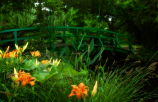Gardens
Water lily pond
Monet was always fascinated by the light interplays and cloud reflections on the water. His many artworks painted on his floating studio, in Argenteuil or on Dutch canals, illustrate his fascination for the upside-down reflections in those liquid mirrors. In 1893, he acquired land at the bottom of Clos Normand, on the other side of the train tracks, and diverted the Ru, a small branch of the River Epte. The pond created by this diversion would become the water garden that features on the picture rails of the world’s greatest museums.

Along the same axis as the Clos Normand’s central path, Monet had a Japanese bridge built, which was undoubtedly inspired by one of his prints but painted green to stand out from the red traditionally used in Japan. The Oriental feel was introduced through the choice of plants, such as bamboo, ginkgo biloba, maple, Japanese tree peonies, lilies and weeping willows, which beautifully frame the pond. Lastly, Monet planted water lilies at the bottom of the pond: “I love water but I also love flowers. That’s why, once the pond was filled, I thought about adorning it with plants. I got a catalogue and simply chose at random.”
Monet was so proud of his water garden that he loved to receive his guests there and spent hours contemplating it. One gardener looked after it full time, removing every dead leaf to keep it beautiful and pristine.
In 1897, Monet started to paint the water lilies. As he sought to capture the atmosphere of this sky-like surface on which floated spots of colour, Monet created one of his greatest artworks and pushed his painting to the limits of abstract art, where the shimmering colours alone evoked a world of sensations and emotions. Today, you can admire ‘Water Lilies’ at Musée de l’Orangerie in Paris and in many museums around the world.
Find out more:
// Musée de l’Orangerie
// Giverny Autrefois














